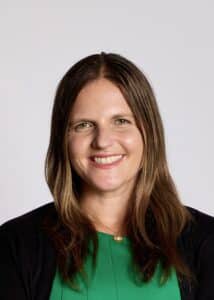As marketers, we are storytellers of the brands we represent. York IE’s Marketer Spotlight series focuses on the individuals who create stories, orchestrate launch strategies, and execute them across all channels. They embody brands and lay the foundation for scalability. Join the best marketers in SaaS as we uncover the stories behind the stories.
Here we speak with Jen Brown, Worldly’s Director of Marketing.

 Everyone has a story. What story do you have?
Everyone has a story. What story do you have?
When I started my career, I was drawn to marketing roles because it provided a way to inspire people and help them do their jobs better. I specifically looked for roles in software and technology because I was fascinated by the innovation in this industry and how it could make a huge difference to society. I was fortunate to start my marketing career at Salesforce. They have an amazing marketing team. While at Salesforce, I had the opportunity to lead marketing for Net Zero Cloud and Salesforce’s sustainability solutions, and I was immediately drawn to the sustainability software space.
What do you like about B2B marketing?
B2B marketing is about showing how new technologies can help your company grow. But it’s not always clear how they work. B2B marketing is the bridge between the innovative technologies your company is developing and your target audience and their needs. It’s a dynamic role because it requires expertise in the products you sell and a deep understanding of your customer base. In Sustainability, I’m marketing solutions that not only help customers do their jobs better, but also improve the world.
How do you derive your marketing goals? How closely are they tied to your company KPIs?
Great marketing is always tied directly to company KPIs that have measurable objectives. I have worked at companies that have followed both OKR and V2MOM frameworks and I believe they are essential for achieving alignment and moving quickly across the company. For marketing objectives, look at what your company and go-to-market (GTM) objectives are and ask how your marketing objectives can support them. Prioritization is also important. Marketing may have 4-6 objectives, but they should always be prioritized. If you only have the resources to execute on your top 3 objectives, you need to know what your top 3 are.
How do you reach your audience?
It really depends on what audience you’re reaching. We’ve found that email, virtual events, and in-person events work very well when trying to reach our current customer base. Short, informative content paired with opportunities for customers to connect with each other and with experts has been very successful.
For potential clients or new logos, go where they spend their time and seek out their expertise. This varies by industry and role. Trade associations, publications, and events are great for finding new audiences. In the sustainability space, there are some major media and industry associations that can help unlock access and drive new leads. People are hungry for information and guidance, so providing useful content through trusted channels is key to getting their attention. There’s also always SEM, SEO, and paid social media, which I think are always-on channels that can help engage people when they express intent to buy the type of software I’m marketing.
What is the biggest challenge you face as a marketer today, and how are you overcoming it?
The sustainability software space is relatively new. It’s not an established category, and many buyers don’t know what their software needs are. Sustainability software purchase decisions are often made by committees. That’s why I have to market my product as a category builder. We’re not in a software category, we’re creating a category. I’ve created assets that help customers evaluate software options and make purchase decisions. I have to make product demos really clear to show exactly how my product can help customers, and my sales team has to provide more expertise than usual because they work with a wide variety of decision makers.
How do you see marketing next year?
Marketing needs to be extremely personalized. Generic messages don’t work across personas or industries. People want to feel like you’re talking to them directly.
I also see marketers becoming more powerful in their skill sets and marketing tech stacks. With AI and new tech solutions, I can manage website content, SEM, email marketing, blogs, video editing, etc. without having to spend years training on how the platforms work.
How much are you using AI?
I have used AI to draft content and help translate it. AI has been invaluable in conceptualizing and drafting product names, blog posts, event session descriptions, and emails. In my current role, I work with companies all over the world, so I use AI to test how well my names and messages translate into other languages.
What else would you like to share with other marketers?
Knowing your audience better than anyone else unlocks your marketing potential. I have developed an expertise in knowing sustainability buyers and have a deep empathy for their work, which makes it much easier to create effective marketing messages and campaigns. Now that I have an audience that I understand, my career path is clearer, and I enjoy my job more because I can develop closer relationships with my customers.


